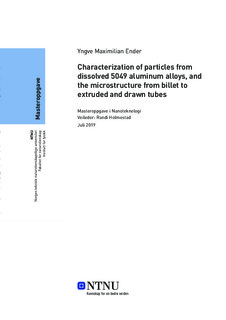| dc.contributor.advisor | Holmestad, Randi | |
| dc.contributor.author | Ender, Yngve Maximilian | |
| dc.date.accessioned | 2019-11-30T15:00:33Z | |
| dc.date.available | 2019-11-30T15:00:33Z | |
| dc.date.issued | 2019 | |
| dc.identifier.uri | http://hdl.handle.net/11250/2631163 | |
| dc.description.abstract | Hydro sin 5049 aluminiumslegering ekstruderes og trekkes til rør for bruk i hovedsakelig bilindustri, hvor den brukes som for eksempel innløps-/utløpsrør for varmevekslere. For å øke fortjenesten er det nødvendig å optimalisere produksjonsprosessen, noe som bare er mulig ved å forstå hvordan legeringen oppfører seg.
Denne avhandlingen tar sikte på å karakterisere dispersoider og presipitater i to forskjellige 5049 aluminiumslegeringer, som er valgt basert på forskjell i observert skrapproduksjon. I tillegg ble mikrostrukturen fra billet til ekstruderte og trukket rør studert for å prøve å forstå hvordan strukturen endret seg gjennom produksjonsprosessen, samt endringen i presipitater.
For å studere partiklene ble prøvene oppløst i butanol for å ekstrahere dispersoider og presipitater. De ekstraherte partiklene ble deretter studert ved bruk av Scanning Electron Microscopy, Energy Dispersive X-ray Spectroscopy, Photon Correlation Spectroscopy, X-ray Diffraction og Transmission Electron Microscopy. Mikrostrukturen av billet til ekstruderte og trekte rør ble studert ved bruk av Polarized Light Microscopy, Electron Backscatter Diffraction, Energy Dispersive X-ray Spectroscopy og Transmission Electron Microscopy.
I prosjektarbeidet, som denne avhandlingen er en videreføring av, ble det funnet at legeringen med en høy rapportert skrapproduksjon hadde en økt mengde partikler med høyt aspektforhold sammenlignet med den andre legeringen med en mye lavere observert skrapproduksjon. Det ble funnet at nålformede presipitater i legeringen var av typen Al6(MnFe) med forskjellige mengder Mn og Fe substituert inn. I tillegg til de nålformede partiklene ble mindre dispersoider av alpha-Al(Mn,Fe)Si fasen også funnet.
Ved oppløsning av aluminiummatrisen ble det funnet at Al6(MnFe) nålene som ble observert i prosjektarbeidet faktisk var plate-lignende partikler, og ikke nåler. Ved hjelp av X-ray Diffraction på det oppløste pulveret pekte det også mot at Mn0,8Fe3,2Al17,1Si1,9 og (Al19Fe4MnSi2)5,31 var i prøvene. En mengde av mulige flukspartikler og konstituent partikler ble også funnet ved hjelp av oppløsning av aluminiummatrisen med butanol.
For mikrostrukturen ble det funnet at områder nær stoppmerker viste kraftig deformasjon, med større rekrystalliserte områder ved siden av det deformerte området. Ved å bevege seg bort fra de rekrystalliserte områdene rundt stoppmerkene, ble mindre rekrystalliserte korn funnet.
Arbeidet som er gjort i denne oppgaven er et lite skritt mot bedre forståelse av hvordan kjemien påvirker skrapproduksjonen av 5049 aluminiumslegering og hvordan mikrostrukturen endres fra billet til ekstruderte og trukket rør. | |
| dc.description.abstract | Hydro's 5049 aluminum alloy is extruded and drawn into tubes for subsequent use in primarily automotive industries, where it is used as for instance inlet/outlet tubes for heat exchangers. To increase profits it is necessary to optimize the production process, which is only possible by understanding how the alloy behaves.
This thesis aims to characterize dispersoids and precipitates in two different 5049 aluminum alloys, that have been selected based on difference in observed scrap rate. In addition the microstructure from billet to extruded and drawn tubes were studied to try to understand how the structure changed throughout the production process for the alloy, as well as the change in precipitates. To study the particles the samples were dissolved in butanol to extract the dispersoids and precipitates.
The extracted particles were then studied using Scanning Electron Microscopy, Energy Dispersive X-ray Spectroscopy, Photon Correlation Spectroscopy, X-ray Diffraction and Transmission Electron Microscopy. The microstructure of billet to extruded and drawn tubes were studied with the use of Polarized Light Microscopy, Electron Backscatter Diffraction, Energy Dispersive X-ray Spectroscopy and Transmission Electron Microscopy.
In the project work, which this thesis is a continuation of, it was found that the alloy with a high reported scrap rate had an increased amount of high aspect ratio precipitates compared to the other alloy with a much lower observed scrap rate. It was found that needle shaped precipitates in the alloy were Al6(MnFe) with various amounts of Mn and Fe substituted in. In addition to the needle shaped particles smaller dispersoids of the alpha-Al(Mn,Fe)Si phase was found.
By dissolution of the aluminum matrix it was found that the Al6(MnFe) needles observed in the project work was in fact plate like particles, and not needles. With the help of X-ray diffraction on the dissolved powder it then pointed towards Mn0,8Fe3,2Al17,1Si1,9 and (Al19Fe4MnSi2)5,31 also being in the samples. A multitude of possible flux particles and constituent particles where also found by extracting particles from dissolution with butanol.
For the microstructure it was found that areas close to stopmarks showed heavy deformation, with larger recrystallized areas next to the deformed areas. Moving away from the recrystallized areas around the stopmarks, smaller recrystallized grains where found.
The work done in this thesis is a small step towards better understanding of how the chemistry effects the scrap rate of 5049 aluminum alloy and how the microstructure changes from billet to extruded and drawn tubes. | |
| dc.language | eng | |
| dc.publisher | NTNU | |
| dc.title | Characterization of particles from dissolved 5049 aluminum alloys, and the microstructure from billet to extruded and drawn tubes | |
| dc.type | Master thesis | |
